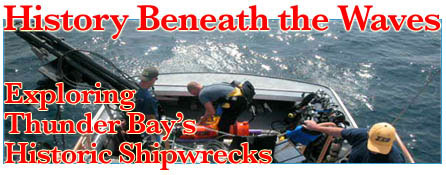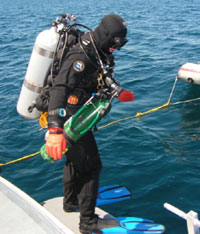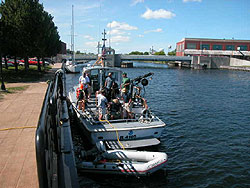
From August 8 to August 24, 2005, the Thunder Bay National Marine Sanctuary conducted fieldwork, funded in part by NOAA’s Office of Exploration, to document deepwater shipwrecks located in the sanctuary.
Under the direction of Russ Green, principal investigator and program and operations coordinator at Thunder National Marine Sanctuary, an experienced team of technical divers and archaeologists investigated two sites: an unidentified schooner located by Dr. Robert Ballard’s Institure for Exploration (IFE) in 2001; and a wooden passenger steamer, Pewabic, that sank in 1865 under mysterious circumstances. The field team, compromised of professionals from Thunder Bay National Marine Sanctuary, East Carolina University, NOAA Maritime Archaeology Center, NOAA Undersea Research Center (NURC) at University of North Carolina-Wilmington, and NURC at University of Connecticut-Avery Point, used innovative mapping and photomosaic techniques to record these wrecks.
Due to the water pressure and risks of breathing compressed gas, deepwater archaeologists do not have the time to map a wreck using conventional “slate-and-pencil” techniques. So they use an efficient and highly effective method, called photomosaic, to acquire the necessary data in the quickest and safest amount of time. Photomosaic technique involves one researcher taking video of the wreck along pre-determined transects and at a specific height above the target (e.g. twenty feet above the main deck of the wreck). To achieve maximum coverage of the wreck, this diver is towed through the water column by another navigating an underwater scooter. The resulting video is converted to still images that is then further worked into a mosaic of the shipwreck. To establish scale, diagnostic measurements are taken from a baseline by other members of the team. The collected data is combined to form a photographic site map that may be applied toward answering research questions and educating the public about shipwreck preservation through interactive media like the internet.
 |
| Diver preparing to enter the water. (Photo: Jeff Godfrey - NURC/UCONN) |
|
|
Work began on the unidentified shipwreck, a two-masted schooner presently called, “Target 7.” Resting in 160 feet of water, this shipwreck was recently located by IFE, making it possible for archaeologists to study a shipwreck before major site disturbance has occurred. It also offers the opportunity for demonstrating how a government entity like TBNMS can effectively document and manage a shipwreck site while also encouraging responsible public access.
After a week’s worth of data collection on “Target 7,” the team moved on to the Pewabic. Built in 1863, the Pewabic was a twin-screw wooden propeller, 200 feet long with a 31-foot beam. She held 1,000 tons of freight and over 200 passengers. On August 9, 1865, she was heading south on Lake Huron when she collided with her sister-ship, the Meteor. The Pewabic’s wooden hull was ripped open on her port side, and cold water rushed into her holds. A few minutes later she was at the bottom of Lake Huron in 185 feet of water. 33 passengers and crew were lost in the disaster. At the time of her sinking, the Pewabic carried a large load of copper and iron with purported amounts of silver. Salvage efforts in the following years saw most of the copper recovered but at the cost of eight more lives.
Due to the mystery and later salvage attempts of the Pewabic, she has become the Sanctuary’s most celebrated wreck, but despite her notoriety, none of her construction plans exist. There are also little known of the building plans of any vessel from that period on the Great Lakes. Therefore, there is much to be learned from her. The archaeological data collected from this expedition will be examined to help determine not how she was constructed, but how she sank, and perhaps shed light on why she and the Meteor collided even though they saw each other from miles away. The data also provides a baseline for future monitoring of the site.
 |
| The team unloading the 41-foot research vessel, Huron Explorer, at the dock after a successful day. (Photo: Calvin Mires - TBNMS) |
|
|
The collected archaeological data will also be used for the following overarching goals. Results from the archaeological documentation and evaluation will be essential in nominating the wrecks to the National Register of Historic Places (NRHP), which is an important component of both preservation and public education. TBNMS will use the data and imagery collected through its photomosaic methodology to educate dive communities of all skill levels and the general public of the importance of preserving the wrecks for all generations. Public outreach is a critical component of the project since many people will never be able to see the wrecks firsthand. Bringing the wrecks “out of the water” through visual imagery and potential interactive exhibits in the Great Lakes Maritime Heritage Center and the internet will promote a stronger connection between present maritime communities with those of the past. Finally, the acquired documentation provides information essential to assess, manage, and interpret the sites accurately and to track the environmental and human impacts that accrue on the wrecks over the coming years.
The 2005 OE research team were Russ Green from TBNMS, Tane Casserly from the Maritime Archaeology Center, Doug Kesling and Jay Styron from NURC-University of North Carolina-Wilmington, Jeff Godfrey from NURC-University of Connecticut, and Steve Sellers, Mark Keusenkothen, Joe Hoyt, and Calvin Mires from East Carolina University.

Additional Resources and Links
East Carolina University Diving
NOAA's National Undersea Research Center/UNC-W
NOAA's National Undersea Research Center/UCONN
|





